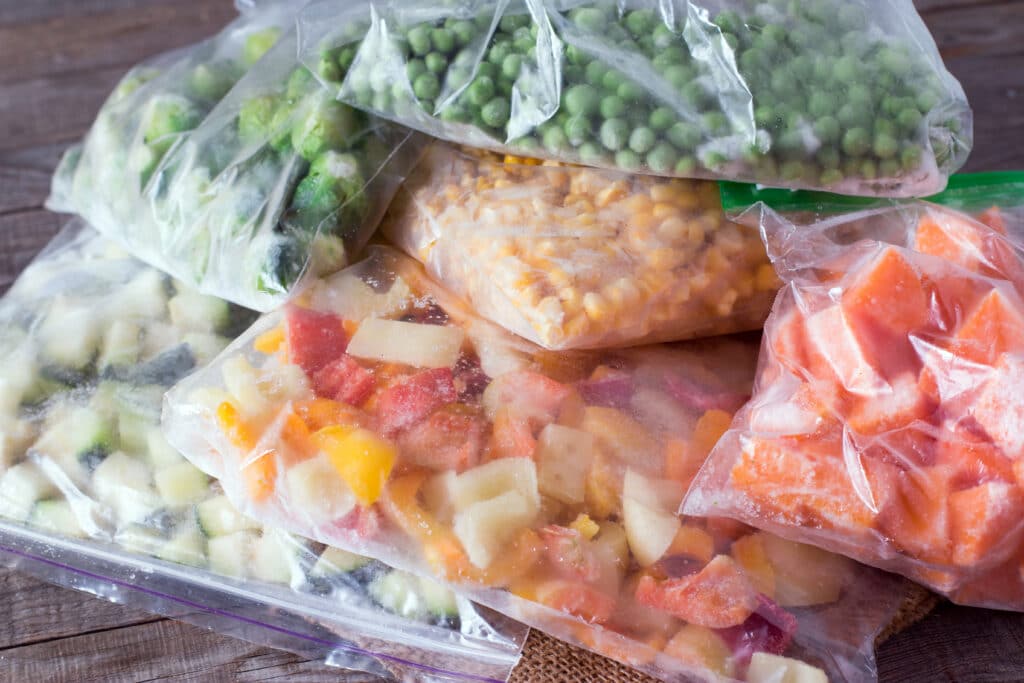
Have you ever wondered which type of produce is superior for nourishment, between fresh, frozen, and canned fruits or vegetables?
The truth is that each of these types of produce has their own distinct advantages, and scenarios in which they perform best. An ideally stocked pantry (or food bank!) would provide a household with all three options, allowing people to mix and match the usage of each type depending on their need.
But which applications are best for canned fruits and vegetables versus frozen, and what about fresh? We’ll explore each type and learn about their unique strengths below.
Fresh Produce

Advantages:
When it comes to flavor, it’s tough to beat fresh produce! When compared to frozen or canned options, fresh fruits and vegetables are considered the gold standard of taste and texture by farmers and foodies alike, and many consider fresh to be the most visually appealing state for produce as well. The majority of recipes in cookbooks and internet cooking websites call for fresh where produce is used, and cooks of all skill levels will appreciate the culinary versatility of fresh vegetables and fruits.
From a nutrition standpoint, fresh produce (when eaten at peak freshness) scores especially high marks. In a Journal of the Science of Food and Agriculture review of studies about the nutritional content of fresh, frozen, and canned fruits and vegetables, researchers noted that fresh vegetables were much more likely to contain high amounts of water-soluble nutrients like vitamins C and B compared to preserved produce.
Limitations:
From the moment that a fruit or vegetable is harvested, the clock on “freshness” is ticking. As it ages, produce loses nutritional content. In the previously mentioned study, researchers indicated that spinach loses 75% of its vitamin C content when stored for a week in a refrigerator. The loss is less severe in hardier vegetables like carrots, but the science is still clear: Fresh produce is really only nutritionally ideal if you’re going to eat it within a few days, and many cooks would agree that taste and flavor also degrade quickly after that time span.
In addition to being the most perishable type of produce, fresh fruits and vegetables are also not equally accessible in all communities. Urban and rural areas with a lack of affordable grocery stores or other food retailers are known as places of food apartheid and residents of these areas have an especially difficult time finding — and affording — fresh produce. In a 2006 Agriculture and Human Values study, researchers noted that residents of areas afflicted by food apartheid often reported low-quality produce and paid significantly more than market rate for their fresh produce — if they were able to find it at all.
Frozen Produce

Advantages:
While produce that’s destined for grocery store shelves is often picked prior peak freshness to allow for travel time and offset some shelf spoilage, producers wait longer to pick fruits and vegetables that are headed for a freezer to maximize their nutritional content, according to CNN Health. Because its nutritional content is held in an arrested state by your freezer, a bag of frozen peas will actually offer a more consistent delivery of nutrients throughout multiple meals during a week than fresh peas, whose nutritional content will degrade.
In a 2015 study in the Journal of Agriculture and Food Chemistry, researchers noted that the vitamin content of frozen produce like corn, broccoli, green beans, and blueberries showed that the vitamin content of frozen produce was comparable to — and occasionally higher than — fresh produce.
Frozen produce also retains more of its “fresh” flavor, texture, and appearance than canned produce, making it a more versatile option for home cooks in many applications.
Limitations:
Fruits and vegetables that are destined for the freezer are quickly cooked for a short period of time before freezing in a process called “blanching.” This process is done to make the produce more stable and retain its “fresh” appearance. However, in the Science of Food and Agriculture review, researchers noted that this blanching stage causes a big drop in water-soluble vitamins like vitamin C.
Frozen vegetables also require a working freezer and electricity to power it, making them an inaccessible choice for some low-income households as well as people experiencing homelessness.
Canned Produce

Advantages:
Canned produce is by far the most shelf-stable and long-lasting form of produce. Similar to frozen produce, canned fruits and vegetables are picked and stored at peak freshness to preserve nutritional content.
In a Michigan State University study, researchers praised canned produce for delivering excellent nutritional value relative to price, which is usually significantly less than that of fresh or frozen produce.
Canned produce also gets high marks for safety thanks to the high heat used in the canning process, which helps prevent the growth of foodborne illnesses. This heating also ensures that canned produce is ready to eat and serve immediately. Plus, due to their hardy exterior, canned fruits and vegetables travel well and can be stored just about anywhere.
Limitations:
Some canned fruits and vegetables can contain additional sugars or salt as part of their preservation process, so health-conscious folks should select canned produce that is sodium-free and stored in its own juice rather than sugary syrup. Canned fruits and vegetables also experience a greater nutrition loss of water-soluble vitamins than frozen produce due to the high heat used in canning, similar to the blanching process used in packaging frozen vegetables.
While canned produce isn’t known for its exceptional flavor or texture relative to fresh or frozen, certain types of canned produce are still widely used in restaurants, especially canned tomatoes and beans.
Choosing between fresh, frozen, or canned produce often involves several factors, including accessibility, cost, storage capabilities, and how soon the item will be eaten. But regardless of which type of vegetables or fruits you opt to consume in whichever form, the key throughline is simple: Eating them! Fruits and vegetables contain important fiber, vitamins, minerals, and other nutritional benefits.
At Food Bank of Wyoming, we provide tens of thousands of pounds of fresh produce at no cost to our Hunger Relief Partners every month so that our neighbors can have the option of enjoying them no matter where they live. And through signature programs like mobile pantries, we distribute millions of pounds of fresh, frozen, and canned produce every year to ensure people for whom those options are better can still get the nutrition they need to thrive. By nourishing our neighbors, we can nourish our community.







